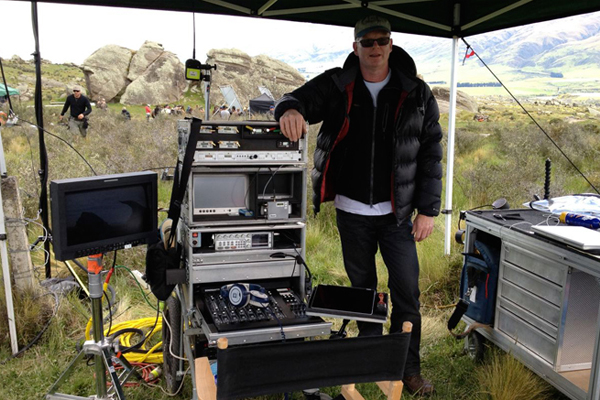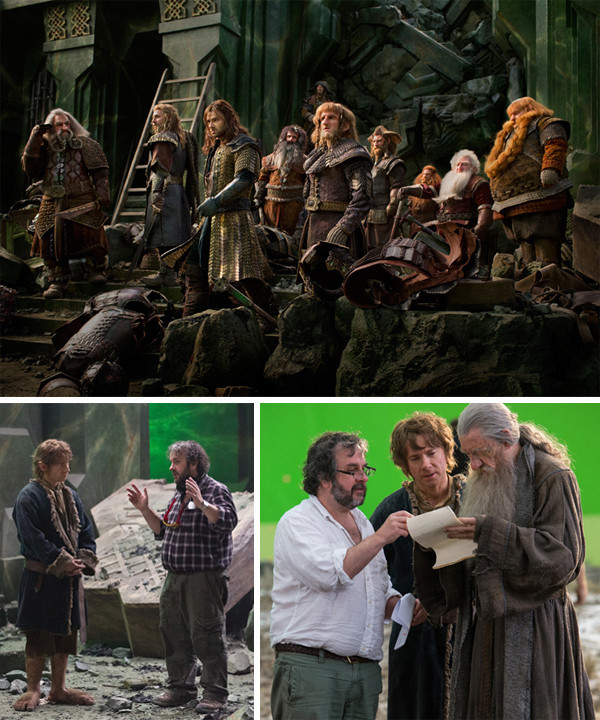The Hobbit: A Production Sound Perspective

Tony Johnson, CAS on location in New Zealand for The Hobbit via Sound & Picture.
If you were a production sound mixer, what if we told you there was a job where you had to live in New Zealand and listen to dwarves, wizards, a hobbit, and other mythical creatures on headphones for a year? Oh, and Peter Jackson is directing. Would you do it? Yeah, it seems like an easy answer, and thankfully one Tony Johnson, CAS was able to say yes to.
If you’re unfamiliar with Johnson’s name, he’s been a sound recordist since the 1980s, tracking films like The Piano, the first Chronicles of Narnia, and James Cameron’s Avatar. Before getting the call to be part of all three The Hobbit films, he even mixed Jackson’s Dead Alive – a must-see for any horror fan. “You don’t often get the opportunity to work on something of this scale with someone like Peter,” says Johnson. “He co-writes the script, conceives the whole thing, and then follows through being very hands on. He’s a true artist. Like Cameron, they grab their ideas tightly and run with them. They don’t get tired of it, and they’re extremely focused. It’s wonderful experience.”
Before wrapping up and returning home, Johnson went on his own epic journey, shooting over 260 production days with eleven weeks of reshoots for the three The Hobbit films – An Unexpected Journey, The Desolation of Smaug, and The Battle of the Five Armies. “Post sound is a big influence on Peter’s films, and they basically had say in if I had the job or not,” admits Johnson. “Historically, they were doing a lot of ADR because Peter’s style of shooting isn’t normally conducive to getting good production sound. Plus there tends to be wind machines on most exterior sets. With that said, it’s vital to have the mics as close to the actor’s mouth as possible, so we went down the wireless route pretty quickly.” Johnson was already a Zaxcom Fusion 10 user and was keen on their digital wireless system and thought to use ZaxNet for the entire trilogy. “Supervising dialogue editor Chris Ward was also following the Zaxcom story so there was no convincing needed,” says Johnson.

via Sound & Picture
Each film created its own set of challenges, but Johnson and his two boom operators, Corrin Ellingford and Steven Harris, consistently took the time to wire all the actors each day. The team used Zaxcom TRX900 transmitters in combination with Countryman B6s, DPA 4063s, and the occasional Sanken COS-11D for lavs depending on the application or actor. For the hobbit Bilbo (Martin Freeman), two lavs were needed at times. “Bilbo had this jacket he wore with lapels on it. What we did was put two wireless lavs, one on each side of his lapels, being Countrymen B6’s. They were placed at identical heights and levels so no matter which way he would swivel his head, the audio would match,” explains Johnson. “It was the first time I used two mics on an actor and it worked very well.” For the fourteen different dwarves, they used little hair clips to hide B6s into their beards. And in the case of Gandalf (Ian McKellen), sound hid a TRX900 with a B6 into the cone of his hat. “That saved so much production sound because it was like having a boom a few inches away from his mouth,” notes Johnson.
Besides their collaboration with wardrobe to find the best transmitter positions, with additional support from 2nd unit production mixer Chris Hiles, the sound team was able to take wiring one step further. “Chris used Zaxcom as well, which allowed us to leave the lavs in costumes, so when characters went from set to set, the interchange was seamless,” says Johnson. “We were also getting the additional benefit of having matching metadata over the run of the films for post.”


